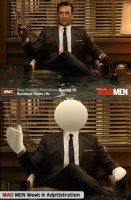One of my favorite Mad Men episodes is Season 2, Episode 4: Three Sundays. The episode incorporates the very real crash of an American Airlines jet shortly after takeoff from what is now JFK airport into the story line. In this episode, the fictional advertising agency of Sterling Cooper is preparing to pitch American Airline executives that have expressed interest in possibly changing advertising firms as a way to mitigate negative press from the crash…

The episode begins with the firm’s employees called into work on Palm Sunday in order to complete a set of marketing proposals for the American Airlines presentation deadline. However, the program’s lead character and head of the firm’s creative department, Donald Draper, decides the best course of action is to concentrate on a single approach. His decision is heavily influenced by the heady progress of the respective time period, spring of 1962, along with his own personal life choices.
Of particular interest is the scene (approximately 30 minutes into the program) where Draper makes this decision known to the entire staff:
Donald Draper (head of creative depart.): American Airlines is not about the past any more than America is…throw everything out.
Paul Kinsey (copy writer): Everything?
Donald Draper: There is no such thing as American history, only a frontier. That crash happened to somebody else. It’s not about apologies for what happened, it’s about those seven men in the room on Friday and what airline they are going to be running.
Salvatore Romano (art director): So what does that mean?
Donald Draper: Let’s pretend we know what 1963 looks like.
This episode originally aired on 8/7/2008, a few months before events that ultimately triggered the current economic downturn and at that time, the orchestra business was aflutter over what to do about rapidly declining audience figures. It seemed that a number of professionals were beginning to think that these sales figures were an indication of the market dictating demand. Conversations were depressing and attitudes were dark.
Fast forward a little more than a year and all of those concerns and attitudes continue to exist but are now accompanied by troubles related to sudden and unexpected budget shortfalls. At this crossroad, the business is not unlike the American Airlines depicted in the 1962 world of Mad Men: there was a crash and dark attitudes were compounded by a lack of experience regarding how to handle crisis driven marketing conditions.
Mad Men’s fictional solution is to set aside conventional wisdom and mistakes in favor of focusing on the future. Moreover, they want to define how that future will look. Once this vision is defined by Draper, the firm completes the work and crafts an entirely new image for American Airlines without changing the company’s core product.
There’s no lesson to learn here; after all, Mad Men is fiction. But fiction provides a sense of freedom to open doors of creativity that are otherwise closed by the pressures of reality. What is beneficial here is that this episode reaffirms some tried and true methods for successfully selling a proven product: create the vision then use it to guide a comprehensive marketing, outreach, development, and education plan that builds an audience base and realizes potential. Not the other way around.
In short, creativity is maximized by forward thinking.
Postscript: Although this piece was written in advance of the news that Honolulu Symphony Orchestra (HSO) was planning to file for bankruptcy, the subject material is perhaps particularly apt when compared against recent comments from the organization’s new executive director in the 11/6/2009 edition of the Pacific Business News. In that article, the HSO’s new executive director, Majken Mechling said this about this organization’s future:
“Our suggested goal was to provide a year-round platform of music for our community that will reflect the desires of the community we serve,” Mechling said. “We want to bring to the residents of Hawaii classical, pop, local entertainment and new musical opportunities that the next generation can embrace, appreciate and sustain for the next 110 years.
In order to do this we must be far more strategic, leaner, more efficient and willing to creatively and artistically work with a substantially smaller core group of musicians that will be the base for our sustainable future,” she said.
Does this vision correspond with the Mad Men example above or does it come across as the sort of apologetic, short-sighted attitude rebuffed by Draper’s character?



You have provided a provocative example in the Honolulu situation.
To me the rather bland “mission statement” quoted in the article reflects an assumption of shrinking opportunities rather than a presentation of exciting new ideas. If not exactly a “surrender”, it is certainly a call to “retreat”.
On the other hand, Chapter 11 is an opportunity to reinvent oneself and hopefully come out stronger at the other end. A smaller core group of musicians may be an appropriate tactical move to get there. But if the ultimate solution is to be “smaller”, it had better be a more exciting “smaller” than the current “bigger” to attract not only audiences but the required financial backing.
“Bland” will not cut it.
I think you hit the nail on the head regarding the proposed plans for a smaller ensemble. In this case, it appears to be be motivated far more by spreadsheets than any quantifiable market research or artistic inspiration.
The HSO situation is not an accident of the economic crash but the end(?) of a long story of poor leadership and bad governance that stretches back a couple decades. This small core orchestra idea has been floating around for a while.
The Board used the combination of the economy, their chronic money problems (stemming from a 2.5yr lockout) and an ED who was a local charity fundraiser with no industry experience as a fig leaf to cover their true agenda. The decision to downsize the orchestra has been a motivation for a long time and they seized this moment so it wouldn’t look too obvious.
My sister lives in Honolulu and I have heard about the ups and downs of this orchestra, as you say, for decades.
Inspiration of audiences and donors should now receive first priority in Honolulu’s restructuring. “Save Our Symphony” campaigns will not be successful without answering the inevitable: “why?”
With all due respect to accountants, operating an orchestra (or any artistic endeavor) primarily as an extension of the spreadsheet pretty much guarantees a “death spiral”.
In reply to Drew’s postscript.
My question is where are they going to find these musicians to achieve this “suggested goal.?”The HSO has not been able to retain players for decades. I assume with a smaller group they will pay the individuals more. I am all for playing all types of music, but does the HSO have a plan to hire a new breed of conservatory musicians who play in all styles mentioned, on $25,000 a year? If the symphony (classical) players are not capable of playing all styles the HSO will have to hire musicians who can. All of this leads to a growing roster and payroll which more and more resembles a symphony orchestra.